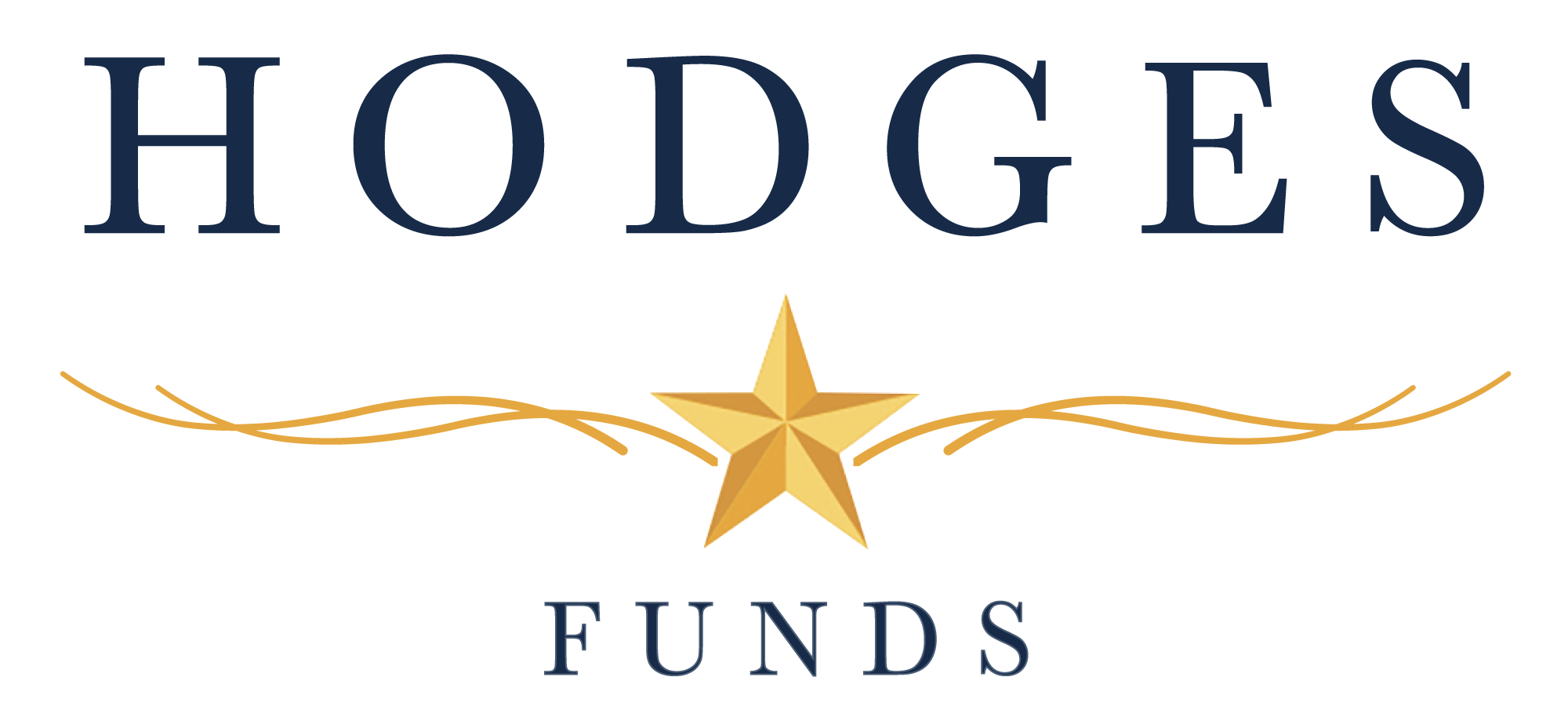Fourth Quarter 2023 Review
by Eric Marshall, CFA, on Feb 01, 2024
No bull market is permanent. No bear market is permanent. There are no stocks that you can buy and forget. Remember, no investment is forever.” -Sir John Templeton.
U.S. stocks finished 2023 on an impressive uptick, with the S&P 500 Index posting a gain of 26.29% in 2023, notching up to a record high at year-end. The fourth quarter rally was largely a repricing of risk as investors digested a moderation in inflation, stable employment, and the possibility of central bank interest rate cuts in 2024. During the final quarter of 2023, the S&P 500 rallied 11.69%. Although full-year performance for the broader market indexes was primarily driven by momentum in a concentrated number of mega-cap growth stocks, the market did see a broader participation in the fourth quarter of 2023, resulting in an 11.89% gain for the S&P 500 on an equally weighted basis. After lagging the broader market most of the year, small caps came roaring back in the final quarter of 2023 and posted their best December in history as regional banks and other cyclically sensitive stocks responded to the idea of looser credit conditions. As a measure of small-caps, the Russell 2000 increased 14.03% in the fourth quarter and was up 16.93% for the year.
In the final months of 2023, we saw a healthy broadening of capital flows into sectors outside of mega-cap technology, which favored stocks with improving balance sheets and whose underlying assets can produce stable cash flow and earnings in a normalizing credit environment. According to the most recent data published by FactSet, the S&P 500 traded at approximately 19.2X its forward earnings estimate at year-end compared to 17.3X at the start of 2023 and a 5-year average of 18.9X. It is worth acknowledging that PE multiples remain highly bifurcated between growth and value stocks. However, value stocks have seen positive relative performance since interest rates peaked on October 23, 2023. The inverse of the year-end S&P 500 PE multiple is an earnings yield of 5.21%, which is still above the 10-year treasury yield of 3.87% at year-end.
With 2023 now in the rearview mirror, our investment team is laser-focused on positioning our portfolios for the year ahead. In 2024, national elections will occur in countries representing more than 40% of the world’s population and 80% of the global stock market capitalization. Although history has proven that capital markets are better at creating economic opportunities than government spending programs, incumbent politicians will be highly incentivized to keep their economies out of a recession this year through fiscal stimulus to improve their reelection chances. Moreover, inflation appears to be moderating compared to this time a year ago. Given the prospects for a more normalizing environment for inflation, we would not be surprised to see new leadership emerge within the domestic market or at least a broader number of stocks participating in any upside from earnings growth and PE multiple expansion. We would point out that many businesses have spent the past two years cutting costs, scrutinizing capital expenditures, tightening supply chains, and cautiously managing inventories in anticipation of a recession that did not materialize in 2023. These actions can often lessen the effects of an inevitable recession on corporate earnings. Furthermore, we believe this is an ideal time to focus on quality stocks at a fair price rather than growth at any price, which is not always measured by market capitalization or reflected in market sentiment. We define quality as those well managed companies that have structural competitive advantages resulting from a differentiated niche, proprietary technology, or unique barrier to entry. Other factors include conservative balance sheets, low-cost operations, and ample liquidity to weather a downturn and, in many cases, take market share from weak competitors.
Our recent discussions with public company management teams over the past few months suggest that supply chains are stable, and many input costs have recently moderated. Although the U.S. economy remains near full employment, consumer spending has become more erratic this year as excess savings built up during the pandemic are no longer a tailwind, and higher costs curtail discretionary consumption of some goods and services. The housing market has slowed due to affordability but is holding up better than feared in many regions due to a lack of existing homes for sale. Furthermore, many companies that we have visited in recent months appear positioned to benefit from onshoring and nearshoring of supply chains and increased infrastructure-related spending. It is also important to note that not every economic cycle looks the same, and not every business will be affected the same by potential macro headwinds. In this environment, active portfolio management becomes essential to navigate quickly changing business conditions across many sectors and position portfolios to potentially benefit from shifting economic trends and structural changes across different industries.
In summary, our investing approach involves spending little time predicting short-term fluctuations in interest rates, foreign currencies, or commodity prices. Instead, we pay close attention to prevailing prices and, more importantly, the earning power our portfolio companies exhibit within their unique businesses. As a result, the investment team at Hodges Capital is rigorously looking for undervalued companies that we believe are well-run and control their destiny by relying on ingenuity and well-calculated business decisions rather than day-to-day momentum in the stock market. Although many uncertainties exist surrounding the global economy and political landscape in 2024, we are overweighting our portfolios with growth and value stocks that we expect to create long-term shareholder value in today’s environment. In these uncertain times, we want to reassure investors in the Hodges Funds that our fundamental investment approach remains steadfast. Moreover, we view the current landscape as an opportune moment for our portfolio managers to meticulously handpick individual stocks that we believe will yield lasting value for our shareholders. Your trust in us means everything, and we're dedicated to upholding our investment discipline.
Returns (% Retail Class) as of 12/31/2023
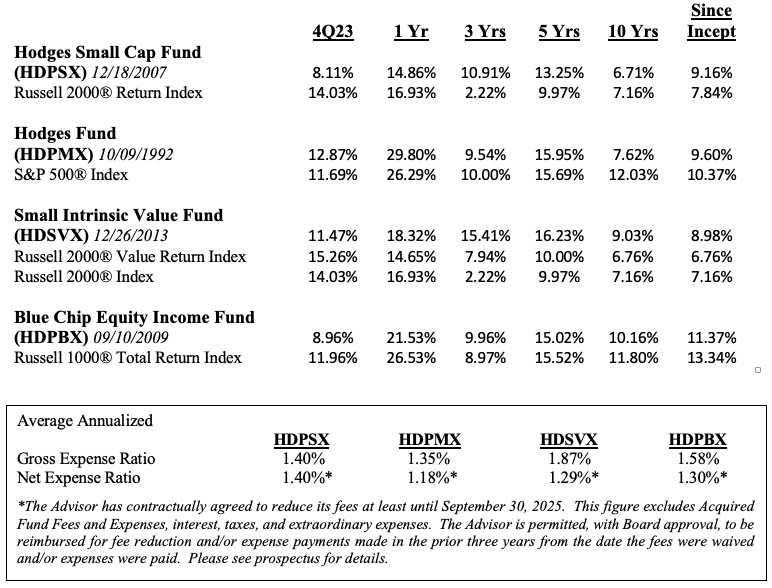
Performance data quoted represents past performance and does not guarantee future results. The investment return and principal value of an investment will fluctuate so that an investor's shares, when redeemed, may be worth more or less than their original cost. The current performance of the Funds may be lower or higher than the performance quoted. Performance data current to the most recent month-end may be obtained by calling 866-811-0224.
The Funds impose a 1.00% redemption fee on shares held for thirty days or less (60 days or less for Institutional Class shares). Performance data quoted does not reflect the redemption fee. If reflected, total returns would be reduced. Performance reflected is net of all other fees and expenses.
Hodges Small Cap Fund (HDPSX)
The return for the Hodges Small Cap Fund amounted to a gain of 8.11% in the fourth quarter of 2023, compared to a gain of 14.03 % for the Russell 2000 Index. The Small Cap Fund's year-to-date performance as of December 31, 2023, amounted to a gain of 14.86% compared to 16.93% for the Russell 2000 Index during the same period. Although small-cap stocks have again underperformed large-cap stocks over the past several years, we view the current risk-reward for holding quality small-cap stocks as attractive. While small-cap stocks tend to experience greater volatility during market turmoil, we expect this segment to generate above-average relative risk-adjusted returns over the long term.
The Hodges Small Cap Fund remains well diversified across industrials, transportation, healthcare, technology, and consumer-related names, which we expect to contribute to the Fund's long-term performance. The Fund recently took profits in several stocks that appeared overvalued relative to their underlying fundamentals and established new positions with an attractive risk/reward profile. The Fund had a total of 48 positions on December 31, 2023. The top ten holdings amounted to 37.31% of the Fund's holdings and included Matador Resources (MTDR), Eagle Materials Inc (EXP), SM Energy Co (SM), Encore Wire Corp (WIRE), Cleveland-Cliffs Inc (CLF), Texas Pacific Land Corp (TPL), Taylor Morrison Home Corp (TMHC), Kimball Electronics Inc (KE), Elf Beauty (ELF), and Hilltop Holdings (HTH).
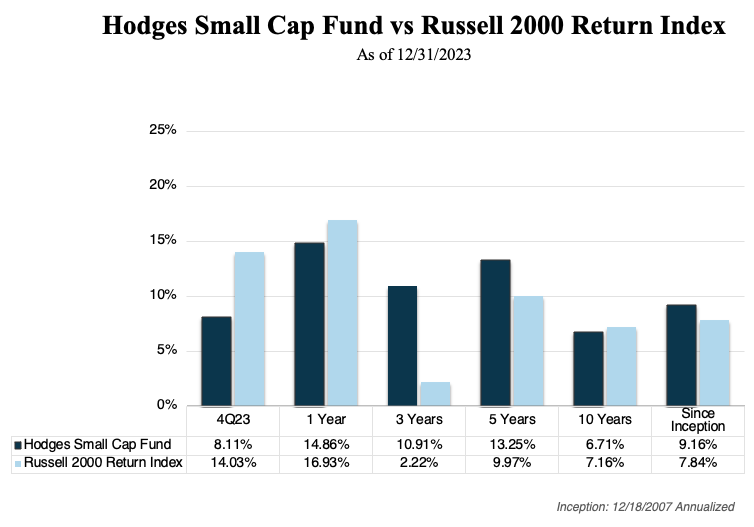
Hodges Fund (HDPMX)
The Hodges Fund's fourth quarter of 2023 return amounted to a gain of 12.87% compared to 11.69% for the S&P 500 Index. For the full year the Fund returned 29.80% compared to a 26.29% return for the S&P 500 Index. Although the portfolio has been underweighted among the seven largest momentum stocks in the S&P 500, positive performance over the past twelve months has been attributed to a handful of industrial, energy, and technology stocks. The Hodges Fund’s turnover was slightly elevated to take advantage of volatile market conditions in the recent quarter. We have upgraded many portfolio holdings into stocks that we believe offer above-average returns relative to their downside risks over the next twelve to eighteen months.
The Hodges Fund's portfolio managers remain laser-focused on investments where we have the highest conviction based on fundamentals and relative valuations. The number of positions held in the Fund at the end of the recent quarter was 38. On December 31, 2023, the top ten holdings represented 45.39% of the Fund's holdings. They included Uber Technologies (UBER), Matador Resources Co (MTDR), Encore Wire Corp (WIRE), On Semiconductor (ON), ProShares UltraPro Short QQQ (SQQQ), DraftKings Inc (DKNG), Texas Pacific Land Corp (TPL), Cleveland-Cliffs Inc (CLF), Shift4 Payments Inc (FOUR), and On Holding (ONON).
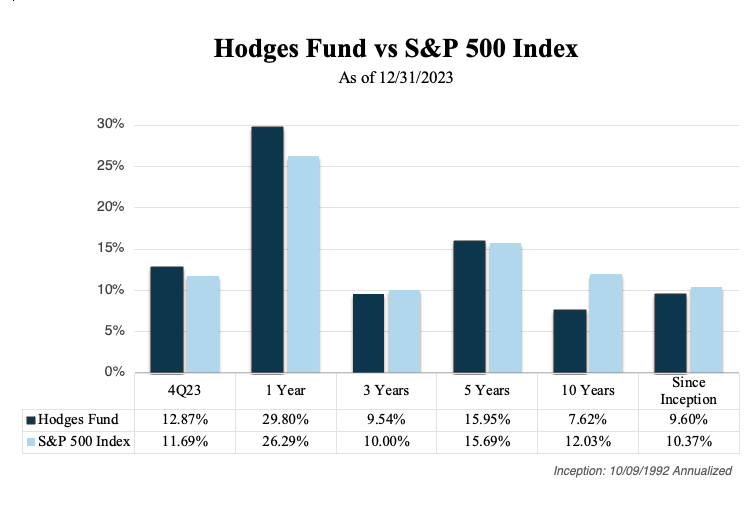
Hodges Small Intrinsic Value Fund (HDSVX)
The Hodges Small Intrinsic Value Fund experienced a gain of 11.47% in the fourth quarter of 2023 compared to an increase of 15.26% for its benchmark, the Russell 2000 Value Index. The Fund’s year-to-date return amounted to 18.32% compared to 14.65% for the Russell 2000 Value Index. Although several energy names were a drag to performance in the year's final quarter, the Fund's solid relative performance over the past year has been attributed to several of the Fund's material, consumer, and industrial stocks. The number of positions held in the Fund at the end of the recent quarter was 48. On December 31, 2023, the top ten holdings represented 34.54% of the Fund's holdings. They included Eagle Materials Inc (EXP), Triumph Financial Inc (TFIN), Ethan Allen Interiors Inc (ETD), Texas Capital Bancshares Inc (TCBI), Hilltop Holdings Inc (HTH), Taylor Morrison Home Corp (TMHC), Chord Energy Corp (CHRD), Shoe Carnival Inc (SCVL), and SunOpta (STKL).
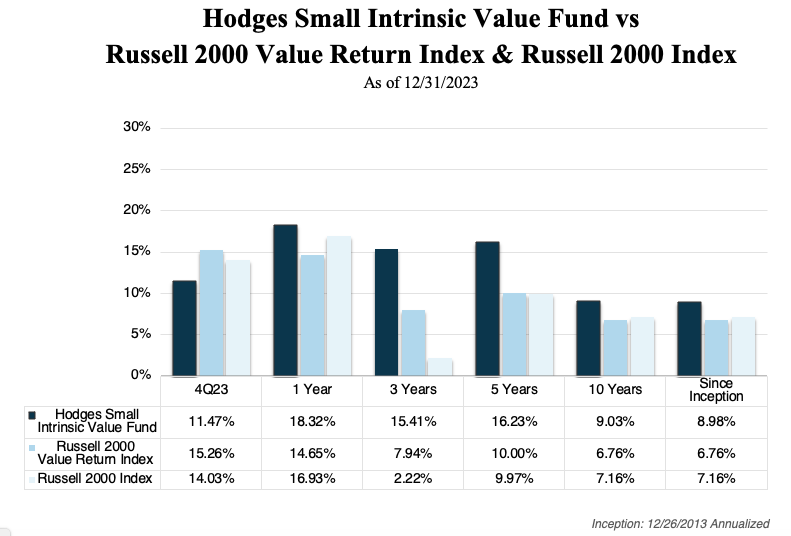
Hodges Blue Chip Equity Income Fund (HDPBX)
The Hodges Blue Chip Equity Income Fund was up 8.96 % in the fourth quarter of 2023, compared to 11.96% for its benchmark, the Russell 1000 Total Return Index. The Fund experienced a year-to-date return of 21.53% compared to 26.53% for the Russell 1000 Total Return Index. Lagging relative performance in the recent quarter and the year was attributed to sector allocation among energy and technology stocks. We believe the current investment landscape offers ample opportunities among high-quality, dividend-paying stocks with solid upside potential. We expect underleveraged balance sheets and corporate profits across most blue-chip stocks to support stable dividends over the next several years. The Blue Chip Equity Income Fund remains well-diversified in companies that we believe can generate above-average income and total returns on a risk-adjusted basis. The number of positions held in the Fund at the end of the recent quarter was 27. The top ten holdings at the end of the quarter represented 46.81% of the Fund's holdings and included Apple Inc (AAPL), Microsoft Corp (MSFT), Nvidia (NVDA), Goldman Sachs Group Inc (GS), Costco Wholesale (COST), Deere & Co (DE), JP Morgan (JPM), 3M (MMM), Exxon Mobil (XOM), and Tesla (TSLA).
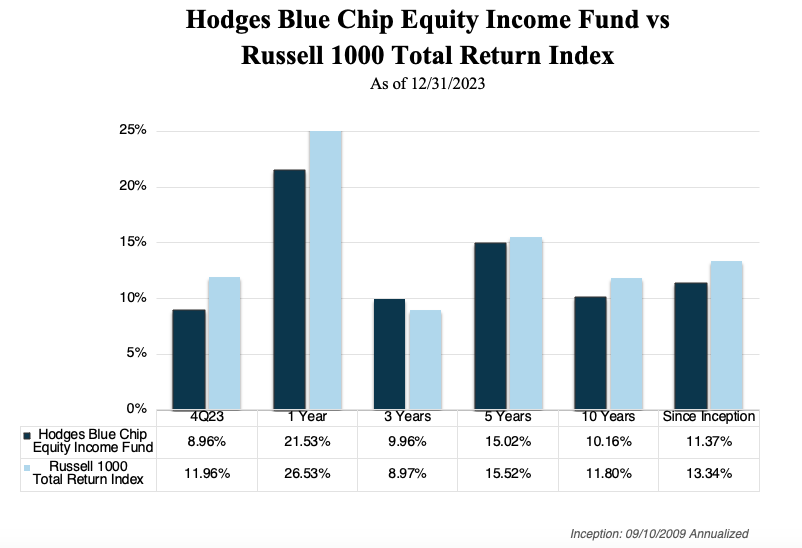
In conclusion, we remain optimistic regarding the long-term investment opportunities surrounding the Hodges Mutual Funds. By offering four distinct mutual fund strategies covering most segments of the domestic equity market, we can serve most financial advisors and individual investors' diverse needs. Moreover, our entire investment team is highly committed to rigorously studying companies, meeting with management teams, and observing trends to navigate today's ever-changing financial markets. Feel free to contact us directly if we can address any specific questions.
The above discussion is based on the opinions of Eric Marshall, CFA, and is subject to change. It is not intended to be a forecast of future events, a guarantee of future results, and is not a recommendation to buy or sell any security. Portfolio composition and company ownership in the Hodges Funds are subject to daily change.
The Fund’s investment objectives, risks, charges and expenses must be considered carefully before investing. The statutory and summary prospectuses contain this and other important information about the Hodges Funds, and it may be obtained by calling 866-811-0224, or visiting www.hodgesmutualfunds.com. Read it carefully before investing.
Mutual fund investing involves risk. Principal loss is possible. Investments in foreign securities involve greater volatility and political, economic and currency risks and differences in accounting methods. These risks are greater for investments in emerging markets. Options and future contracts have the risks of unlimited losses of the underlying holdings due to unanticipated market movements and failure to correctly predict the direction of securities prices, interest rates and currency exchange rates. These risks may be greater than risks associated with more traditional investments. Short sales of securities involve the risk that losses may exceed the original amount invested. Investments in debt securities typically decrease in value when interest rates rise. This risk is usually greater for longer term debt securities. Investments in small and medium capitalization companies involve additional risks such as limited liquidity and greater volatility. Funds that are non-diversified are more exposed to individual stock volatility than a diversified fund. Investments in companies that demonstrate special situations or turnarounds, meaning companies that have experienced significant business problems but are believed to have favorable prospects for recovery, involve greater risk.
Value investing carries the risk that the market will not recognize a security’s inherent value for a long time, or that a stock judged to be undervalued may be appropriately priced or overvalued.
Diversification does not assure a profit or protect against a loss in a declining market.
Fund holdings and/or sector allocations are subject to change at any time and are not recommendations to buy or sell any security.
Investment performance reflects fee waivers in effect. In the absence of such waivers, total return would be reduced.
The S&P 500 Index is a broad-based unmanaged index of 500 stocks that is widely recognized as representative of the equity market in general. The Russell 1000 Index is a subset of the Russell 3000 Index and consists of the 1,000 largest companies comprising over 90% of the total market capitalization of all listed stocks. The Russell 2000 Index consists of the smallest 2,000 companies in a group of 3,000 U.S. companies in the Russell 3000 Index, as ranked by market capitalization. The Russell 2500 Index consists of the smallest 2,500 companies in a group of 3,000 U.S. companies in the Russell 3000 Index, as ranked by market capitalization. The Russell 3000 Index is a stock index consisting of the 3000 largest publicly listed companies, representing about 98% of the total capitalization of the entire U.S. stock market. The Russell 2000 Value Index measures the performance of small-cap value segment of the U.S. equity universe. It includes those Russell 2000 companies with lower price-to-book ratios and lower forecasted growth values. The Russell 2000 Value Index is constructed to provide a comprehensive and unbiased barometer for the small-cap value segment. The Index is completely reconstituted annually to ensure larger stocks do not distort the performance and characteristics of the true small-cap opportunity set and that the represented companies continue to reflect value characteristics. The NASDAQ Composite Index is an index of more than 3,000 common equities listed on the NASDAQ stock market. You cannot invest directly into an index.
Cash Flow: A revenue or expense stream that changes a cash account over a given period.
Price/earnings (P/E): The most common measure of how expensive a stock is.
Earnings Growth is not a measure of the Fund’s future performance.
Hodges Capital Management is the Advisor to the Hodges Funds.
Hodges Funds are distributed by Quasar Distributors LLC.
17783185-NLD 01/10/2024


